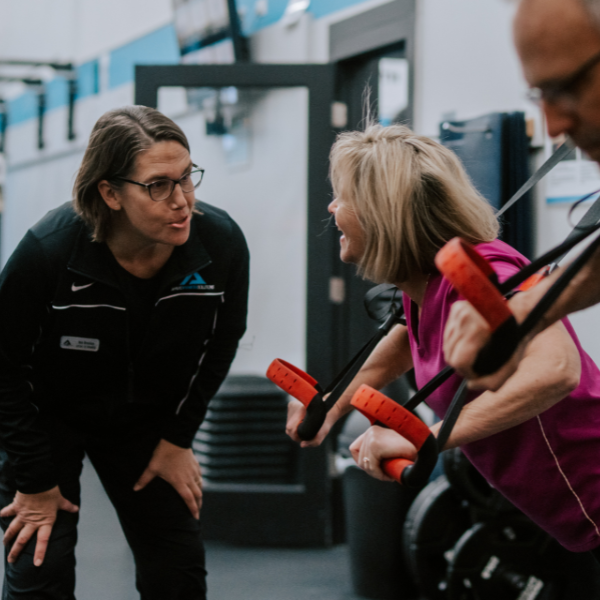Remember adolescence? Or if you’re a mom, remember being pregnant? Those were exciting times punctuated by an emotional roller coaster thanks to wildly fluctuating hormone levels. And then when you’re around 40, just when you might hit your stride in your career or really get to enjoy some “me” time, the menace that is your hormonal regulatory system starts to wreak havoc once again. And there’s no prom or baby shower this time. It’s just menopause coming to remind you that you’re no longer young and fertile. Don’t despair, however, because menopause offers some unique health opportunities – in addition to bidding farewell to tampons and birth control.
If you are around age 40 or above, you might start noticing some changes in your body. Your experience might be similar or it might be very different from same-age friends. Nevertheless, perimenopause and menopause happen. Starting and/or maintaining a regular exercise program can prevent physiological complications that can be exacerbated by menopause, plus exercise can aid in alleviating some of the unpleasant symptoms that some women experience during this transition.
BENEFITS OF STRENGTH TRAINING FOR WOMEN APPROACHING MENOPAUSE
Strength training provides myriad benefits, and is strongly recommended for women of all ages. Estrogen, a female sex hormone produced in the ovaries, has played a key role since before you were born in regulating many of your body’s systems, including bone formation. As estrogen production decreases during the menopause transition, your muscle mass and your bone density will decrease, which increases your risk of developing osteoporosis. While your individual risk for osteoporosis will depend on several genetic and lifestyle factors, the fact remains that your bone density will decrease as you go through the menopause transition, and will continue to decrease as you age after menopause.
IMPROVE BONE HEALTH
Strength training is a potent defense against bone density loss. Your bones are constantly evolving – new bone tissue is built, and old bone tissue is broken down – throughout your lifespan. Strength training stimulates the muscle tissue that is attached to your bones. Muscle stimulation then stimulates bone growth. Weight-bearing exercise such as walking and running can also stimulate bone growth.
A nationally certified Health Coach can help you design a strength training program if your goal is increasing bone health. Be clear with your coach about your goals, your health history, and your fitness background, including recent and past injuries. An optimal bone-strengthening fitness program will include strength training of all the major muscle groups. Aerobic conditioning, flexibility, and balance training are also important components of any exercise program. The sample program below can help you get started. The exercises listed here are common in any gym. If you are exercising at home, the program can be modified to suit typical home equipment such as dumbbells and a bench. Note the intensity column suggests you start out with only moderate intensity for the first few weeks. This is the time to concentrate on correct form, breathing, and body awareness.
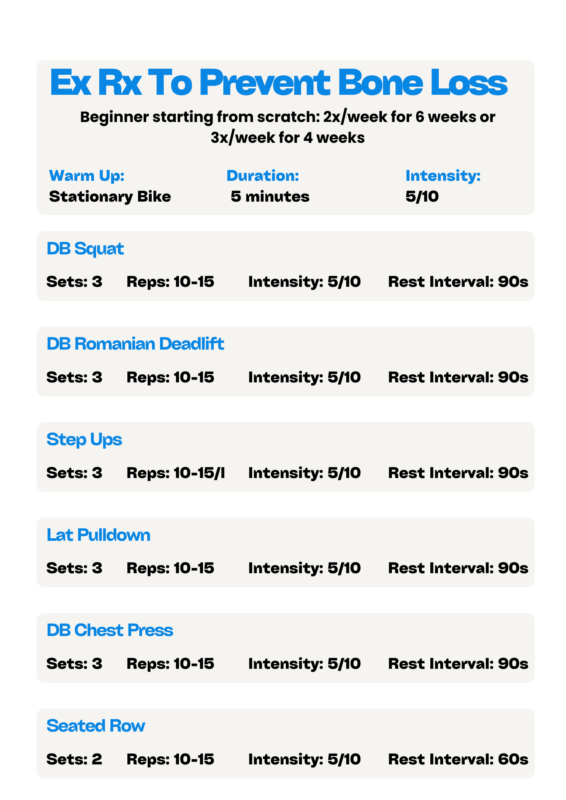
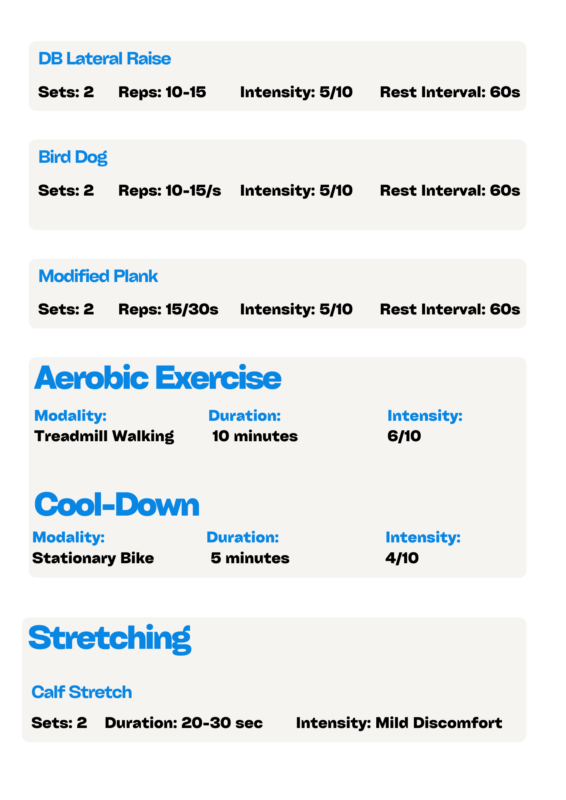
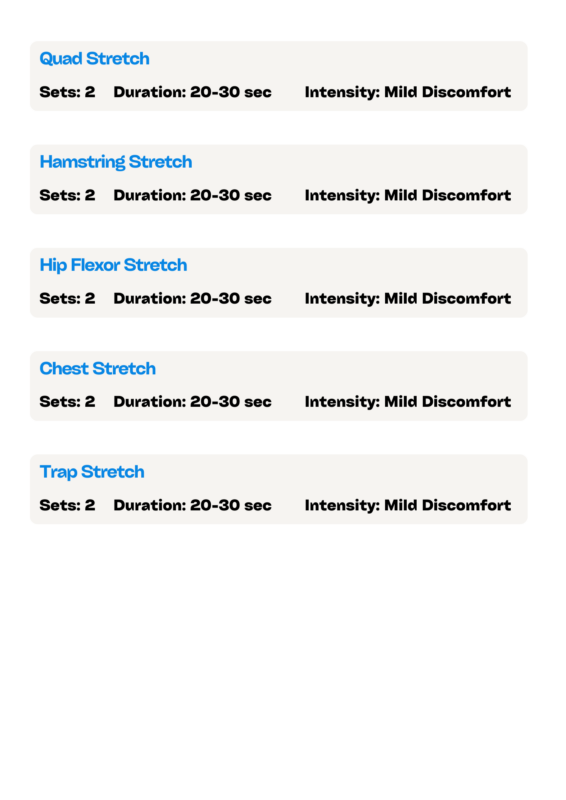
Progression:
The table below provides an example of how you might progress in the above strength training workout. A nationally certified Health Coach can help you individualize the training blocks and suggest exercise variations to keep you interested. The takeaway is that you need to gradually increase the intensity to reap the benefits of strength training. Intensity often correlates with the amount of weight you’re lifting. When 50 pounds feels easy during the last few reps, try 55 on the next set and see if you can still achieve the desired rep range. Your effort levels, consistency per week, and your proper form in each exercise will be key determinants in building muscle mass and strength which will have a noticeable positive effect on bone density.
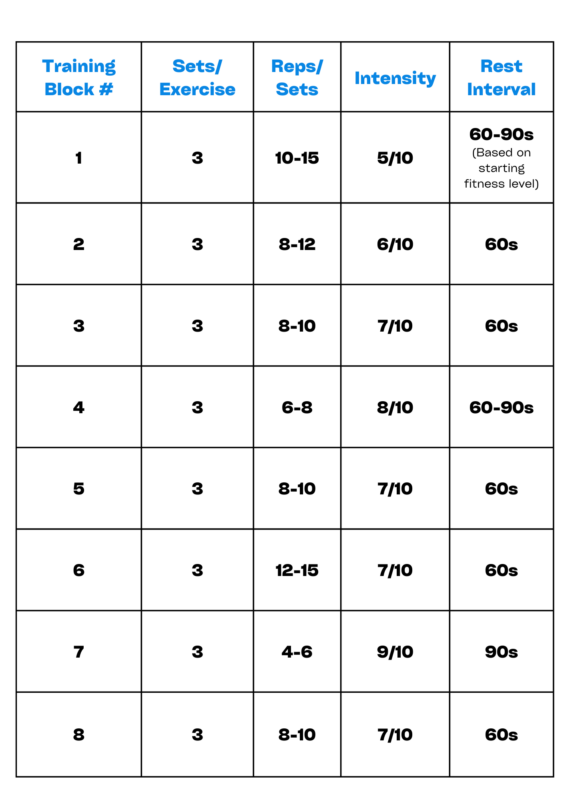
As strength training becomes a habit, you will benefit from varying your exercise selection, and even choosing more specific areas to focus on. For example, perhaps you want to set a goal to work towards. Maybe you want to enter a competition for a sport, or maybe you want to take a trip that requires a high level of fitness. The exercises you choose in progressing toward that goal will undoubtedly also stimulate bone growth.
IMPROVE STRENGTH AND POWER
Beyond the bone health that the above strength training program promotes, you will also improve the functional capacity of your muscle. Like bone density, muscle mass and function decrease with aging. Muscle mass and strength are vital components of a healthy life for everyone – not just athletes. The loss of muscle mass and strength that often accompanies aging can make everyday activities more difficult. Your skeletal muscles are a “use it or lose it” type of tissue. We encourage strength training because it’s the most effective way to prevent your muscles from deteriorating.
Power refers to your ability to apply force quickly, i.e. move a weight fast. An everyday example of power is your ability to stand up quickly from a seated position. Because power is the first muscular quality to decrease with aging, it’s important to incorporate exercises that emphasize power into your exercise routine. These might include some speed squats, medicine ball slams, or kettlebell swings. A nationally certified Health Coach can help you select the most appropriate exercises and to encourage proper form. To find out more about the importance of muscular power, check out this blog post: Why Muscular Power is Essential for Fitness & Function.
PREVENT CARDIOVASCULAR DISEASE
In addition to the increased risk of osteoporosis due to the lack of estrogen protecting your bones, menopause also causes an increase in cardiovascular disease risk. Although cardiovascular disease is still the number one cause of death in women in the US, there are ways to reduce your risk. Just like with osteoporosis risk, your individual risk of cardiovascular disease depends on genetics and lifestyle factors. When estrogen’s protective effects on the cardiovascular system are removed, women’s cardiovascular disease risk often increases due to an increase in LDL cholesterol (often called “bad cholesterol”), a decrease in HDL cholesterol (often called “good cholesterol”) and an increase in insulin resistance. These three changes in your blood makeup each contribute to increased risk of blockages that can lead to cardiovascular disease.
Exercise is a well-documented tool for the prevention of cardiovascular disease. Risk increases naturally as people age, then the risk increases more sharply when the effects of the cessation of estrogen are factored in. The exercise program below contains strength training and aerobic exercise, and it meets the CDC’s recommendation of 150 minutes per week of aerobic activity plus at least two days of resistance training.
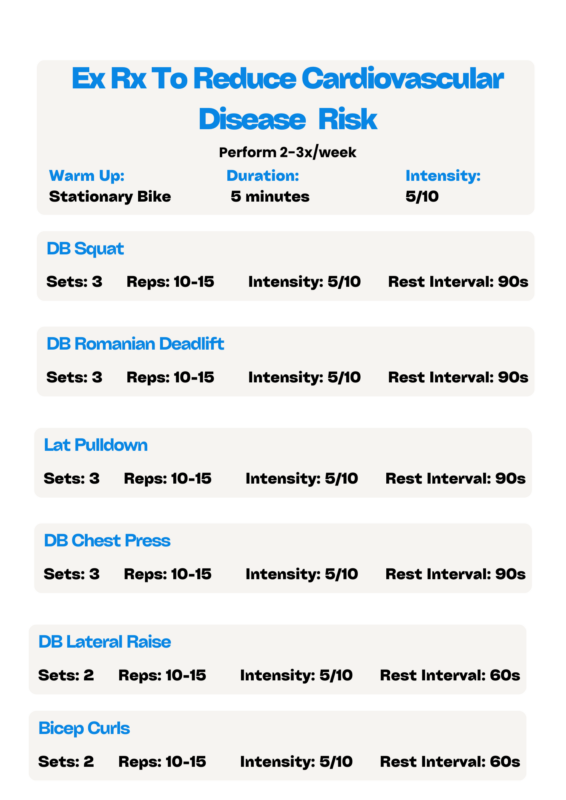
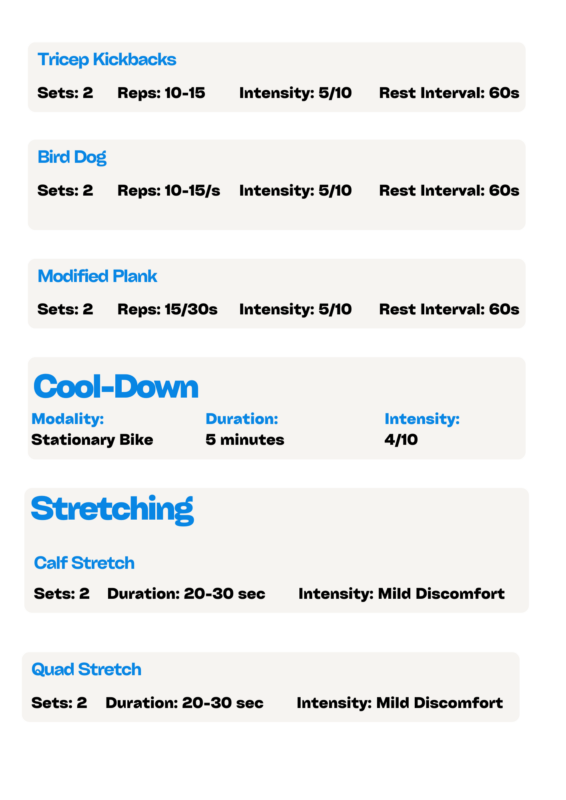
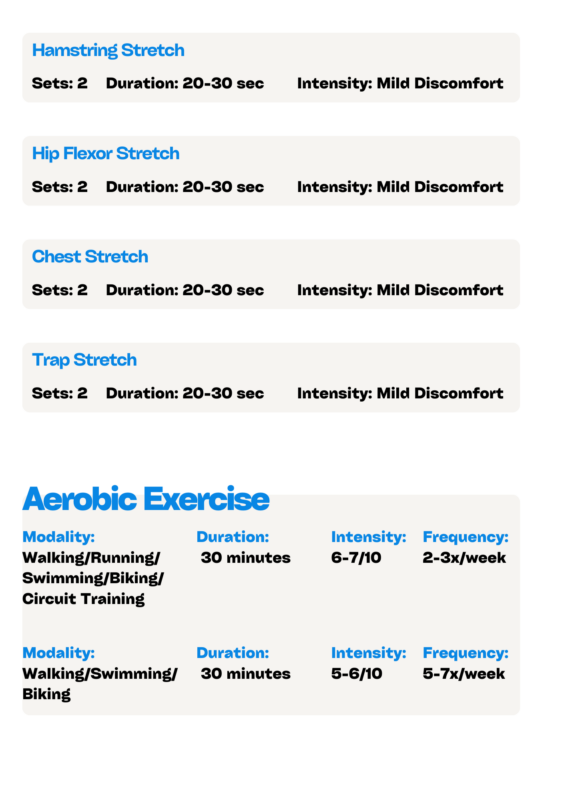
Progression:
The table below provides an example of how you might progress in the above strength training workout. A nationally certified Health Coach can help you individualize the training blocks and suggest exercise variations to keep you interested. The takeaway is that you need to gradually increase the intensity to reap the benefits of strength training. Intensity often correlates with the amount of weight you’re lifting. When 50 pounds feels easy during the last few reps, try 55 on the next set and see if you can still achieve the desired rep range. Your effort levels, consistency per week, and your proper form in each exercise will be key determinants in building muscle mass and strength which will have a noticeable positive effect on bone density.
Monitoring your heart rate is an effective way to gauge intensity in aerobic exercise. For example, if you begin a 3 day per week one mile brisk walk for 30 minutes, you will notice after a few weeks that your heart rate does not increase as much in week four as it did in week one. Therefore you will need to either walk more quickly to cover more distance in the 30 minutes, or increase your intensity by carrying some weights in your hands or in a backpack – anything to get your heart rate to increase during your walk. Same principle applies to whatever aerobic mode you choose.
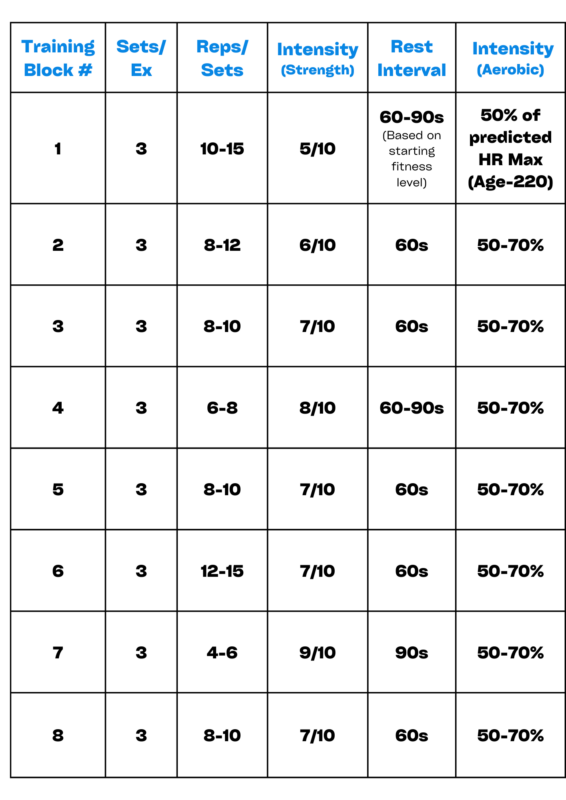
BARRIERS TO EXERCISE AND WAYS TO OVERCOME THEM
The exercise programs described above are examples of effective plans that a hypothetical woman might adopt with the goal of reducing disease risk. The reality is more nuanced, however. Many women face challenges related to exercise, and this section suggests some ways to reduce barriers so that you feel like you can start an exercise program on your terms.
MENOPAUSE SYMPTOMS
First of all, some women suffer greatly from perimenopause symptoms. Hot flashes, poor sleep, and night sweats can make you feel terrible and in no mood to start an exercise routine. However, perhaps it’s motivating to learn that 30 minutes of moderately intense exercise has been shown to improve sleep quality and to reduce hot flashes and night sweats. As estrogen levels fluctuate wildly during the menopause transition, your body’s blood vessels can sometimes rapidly constrict or dilate which can cause your body’s thermoregulatory controls to be disrupted, hence the hot flashes and night sweats. Because exercise dilates your vessels, it’s thought to play a role in reducing the frequency of hot flashes.
Cognitive/emotional symptoms that occur during the menopause transition include increased depression, anxiety, and brain fog. Exercise’s mental health benefits are well-known. Reduced symptoms of depression and anxiety as well as improved cognitive function are common positive effects of starting an exercise program. Although precise exercise prescriptions and doses continue to be studied, the safety and low-risk nature of exercise make it an easy recommendation for women experiencing cognitive and/or emotional symptoms brought on by menopause. Many exercise physiologists say that “the best exercise is the one you want to keep on doing.” For someone struggling with mental health issues, a recommendation to start doing something you find pleasant is more likely to become a sustainable habit. Certainly the programs for bone density and cardiovascular disease outlined above would likely also bring improvements to depression and anxiety symptoms, as well as improvement in cognitive function. The key to exercise as an effective tool is to be consistent and to make an effort. This can be difficult for someone without a regular exercise routine, which is why it’s important to find something enjoyable. It can help to start small: a walk, a yoga video, a once per week dance class, then as confidence builds, the frequency and intensity can also increase.
PRIOR HEALTH CONDITIONS
Health issues can pose another barrier to exercise. If you have a chronic condition or an injury or other orthopedic issue, then perhaps some of the exercises in the above programs aren’t appropriate for you. A certified personal trainer can help you modify or customize a risk-reduction program that takes into consideration your individual circumstances, whether you’re a cancer survivor or have an autoimmune condition or have any musculoskeletal limitations.
“I DON’T HAVE TIME”
This phrase is familiar to so many people. You’re busy, you’re tired, you have work, you might have kids and/or aging parents who require your energy and attention, and you also need time to recharge. How can you fit in exercise? Here are a few tips to get you started:
-Start small. We touched on this previously in the menopause symptoms section, and it bears repeating. If you’re trying to increase your daily activity, try squeezing in a walk or a set of stairs into your day.
-Recruit a partner. See if a friend or family member wants to walk or try something new with you. It can make a huge difference to have this “accountability partner” in addition to just being able to spend a little extra time with someone you enjoy being with.
-Substitute a passive activity with an active one. Perhaps instead of dinner and a movie, it’s dinner and a walk. Or before the next episode automatically comes on, put on a yoga video.
-Remember that everything counts. It’s better to do a shorter workout because you started late than to skip it while you wait for the perfect opportunity. Any additional physical activity or movement you can squeeze into your day adds up to help you stay strong and healthy.
NUTRITION AND RECOVERY IN MENOPAUSE
Nutrition is important for anyone starting a new exercise program, and even more so if you’re going through the menopause transition. In the section about the increase in cardiovascular disease risk that comes with the cessation of estrogen production, we noted that insulin resistance can increase. Dietary strategies to combat insulin resistance focus on reducing consumption of simple sugars in favor of high fiber complex carbohydrates. The DASH and Mediterranean diets have been shown to be effective in improving insulin-resistance in non-diabetics.
For bone health, consuming more calcium, vitamin D, and protein is essential. If you are interested in embarking on a strength training program, increasing your protein intake in particular will help you stimulate the muscle tissue to promote bone growth.
Weight gain, especially abdominal, is another unpleasant side effect of the menopause transition, caused by your overall metabolism slowing down in addition to the cessation of estrogen production. You might be motivated to increase your activity level so that you’re burning more calories with the hope of losing the excess weight. This strategy can sometimes backfire because the increase in activity can often make you feel hungrier, and you might consume even a slight increase in calories without realizing it. A registered dietitian can suggest an individualized food plan that provides the energy you need plus ideas for reductions that can lead to sustainable weight loss if that’s your goal.
Recovery and sleep are also important to consider when starting a new exercise program. Building muscle requires time in between the bouts of stress you’re placing on your muscle tissue. You can see in the sample workouts we prescribed rest intervals between the strength training sets. These recovery periods are essential to get the most benefit from strength training workouts. In addition, it’s important to give your muscles time to recover in between strength training sessions. Aim for 48 hours between strength training sessions that involve heavy lifting using similar muscle groups to maximize the benefits. Cardio training requires shorter recovery periods, and as you become accustomed to your cardio routine, it’s safe to do cardio every day.
Poor sleep is another symptom often associated with the menopause transition, and can exacerbate the other symptoms you might be experiencing. Adequate quality sleep will help you achieve better results from your workouts. The following suggestions may help you get a better night’s sleep:
-Develop a consistent sleep/wake time (even weekends)
-Avoid eating/drinking before bed
-Develop a bedtime routine (stretching/shower/reading/journaling etc)
-Avoid screens in bed (both the light and the stress from the content can disrupt sleep)
-Keep room cool and dark
-Sleep apnea (sometimes excessive snoring can be a symptom) needs diagnosis/treatment from a doctor
FAQs:
- What about Hormone Replacement Therapy?
HRT used to be prescribed routinely for women as they approached menopause. Then a major research study on its risks and efficacy, The Women’s Health Initiative, released some early findings suggesting that the risks outweigh the benefits. Then prescriptions decreased. More recently however, studies are showing that HRT is safe and effective for many women. Because there can be an increased risk of certain cancers and/or cardiovascular disease, it’s important to talk to your doctor first about your symptoms and your individual risk profile.
- What about surgical menopause and exercise?
Surgical menopause is when your ovaries (sometimes with or without your uterus) are removed via surgery. In this case the estrogen production ceases immediately. Some women are prescribed HRT (depending on their risk/benefit calculation). But the effects of the loss of estrogen are the same as if the cessation had occurred without surgery. Thus exercise to prevent bone density loss and cardiovascular disease would still be very beneficial.
- What about changes in pelvic area organs and tissue?
The aging process combined with the depletion of estrogen can bring about changes in the tissues in the pelvic region. Sometimes these changes are accompanied by symptoms such as increased urinary incontinence and/or changes in sexual function. The North American Menopause Society, based on its review of the scientific literature, recommends yoga, and specifically kegel exercises, to combat these changes. The following explanation of kegel exercises comes from their website:
Kegel exercises involve contracting and relaxing the muscles of your pelvic floor, which holds your uterus and bladder in place above your vagina. The aim is to improve the tone of these muscles, which can have the following benefits:
- Increasing strength and awareness of the muscles involved in pleasurable sexual sensations, which can help some women achieve orgasm
- Reducing vaginal or pelvic pain during sex
- Improving some forms of urinary incontinence
- Preventing or treating pelvic organ prolapse, in which the uterus or bladder bulges into the vagina
The key to doing Kegel exercises is identifying the right muscles to contract and relax.
The key to doing Kegel exercises is identifying the right muscles to contract and relax. One way is to try to stop the stream of urine while you’re urinating; if you can do it, you’ve identified the basic move. (But don’t start and stop your urination on a regular basis, as that might do harm.) Always try to do Kegel exercises with an empty bladder. Aim to hold your contractions for 2 to 3 seconds and then release. Once you’ve gotten the hang of the technique, try to do five sets of 10 repetitions per day while performing routine tasks such as driving or sitting at your desk. If you have trouble with the technique, you can get guidance from your healthcare provider, who might refer you for pelvic floor physical therapy
About the Author:
-

When it comes to academic experience, Ann has that in spades. What isn’t documented in the credentialing is Ann’s genuine and welcoming personality. Don’t be surprised if you see Ann lingering a bit longer after classes or in the lobby as she truly enjoys “peop-ling” more than most. When not in the facility, Ann is traveling, reading, swimming or participating in one of her book clubs. On top of that, she appreciates quality time with her husband, Karl, and two children, Joe and Sigi.
Ann earned Master’s in Exercise Physiology from Eastern Michigan University. She holds 3 American College of Sports Medicine certifications; Personal Trainer, Cancer Exercise Trainer, and Clinical Exercise Physiologist. She also holds the Certified Strength & Conditioning Specialist credential from the NSCA.
Her clinical experience in cardiac rehab and stress testing informed her more recent work running positive evidence-based programs. What does this woman not do? You can ask her when you come meet us.
